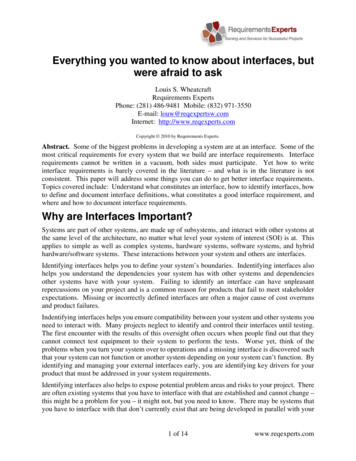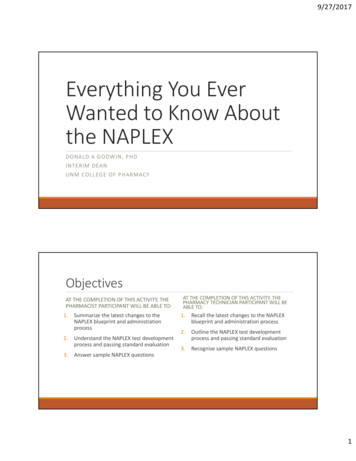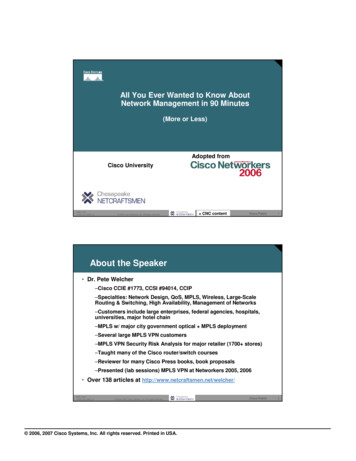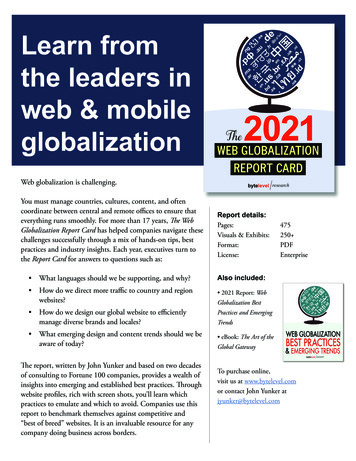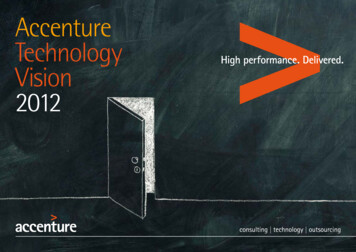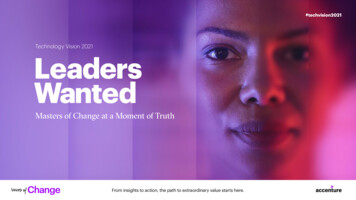
Transcription
#techvision2021Technology Vision 2021LeadersWantedMasters of Change at a Moment of TruthFrom insights to action, the path to extraordinary value starts here.
Introduction1234#techvision20215ForewordThe past year has shown us thattechnology is a lifeline for economies,governments, companies, and people.It changed the way we see andunderstand the world.It also pushed a giant fast-forward button to thefuture. Amid 2020’s challenges, many organizationslacked the digital foundation needed to rapidly pivot,and were confronted with a stark reality: a digitalperformance gap that widened seemingly overnight.Yet, other leading organizations stepped up to usetechnology in extraordinary ways to keep theirbusinesses and communities running—at speedsthey thought previously impossible.At Accenture, our cloud capabilities made thedifference. They helped us pivot our global workforceto a remote-first approach, keeping our employeessafe, productive, and ready to seamlessly serve ourclients and partners in industries around the world.Technology Vision 2021 Leaders WantedNow, as we start to turn the page fromthe challenges of 2020, we’ll also turn to thepower of technology to restore confidenceamong employees, consumers, partners,and our communities. We can build new waysof working and interacting, add much-neededadaptability and resilience, and create newexperiences and ways of doing business. Newlyaccelerated digital transformations give us themeans to serve these needs. But our efforts willbe effective only when we work to build andpreserve trust at the same time.technology change to completely reimagineand rebuild the future of business and humanexperience post Covid.We know this is possible because we’ve seen it.When the “normal” ways of operating were removedfrom the equation, organizations proved they couldwield technology to try new things, change withunprecedented speed, and innovate their wayforward, responsibly and transparently. We nowhave a once-in-a-generation opportunity to turnthis moment of truth for technology into a momentof trust—embracing the power of exponentialJulie SweetChief Executive OfficerAs you learn about the trends in this year’sTechnology Vision, think about how you can applythem to reimagine and replatform your business—leading the change that is needed for yourorganization, for your people, and for our world.Paul DaughertyChief Technology &Innovation Officer2
duction4710131620A new kind of leadershipLeadership Demands Technology LeadershipLeaders Don’t Wait for a New Normal, They Build ItBroaden the Horizons of LeadershipOur Moment is Now: 2021 Technology TrendsCompleting the pictureTrend 1: Stack StrategicallyArchitecting a Better FutureTrend 2: Mirrored WorldThe Power of Massive, Intelligent, Digital TwinsTechnology Vision 2021 Leaders Wanted53Trend 3: I, Technologist65Trend 4: Anywhere, Everywhere83Trend 5: From Me to We99About the Technology Vision102ReferencesThe Democratization of TechnologyBring Your Own EnvironmentA Multiparty System’s Path Through Chaos3
Introduction12345#techvision2021The world is hungry for a new kind of leadership.Amid the challenges of 2020, two truths becameevident. More companies than ever have embracedthe axiom that every business is a technologybusiness, and they’ve ignited a new era of exponentialtransformation as technology continuously reshapesindustries and the human experience. Now, as webegin shaping our post-pandemic reality, companiesmust learn to master change.Technology Vision 2021 Leaders Wanted4
Introduction1234#techvision20215For years, enterprises have been optimistic in theirself-assessments, thinking they’re further along intheir digital transformations than they really are.Adaptability, innovation, connectedness—pick ametric and businesses asserted they were leadersin the space, ready for anything. But 2020 andthe COVID-19 health and economic crisis clearedtheir rose-colored glasses, bringing a new realityinto sharp focus: Inflexible work arrangements andoperations. Fragile supply chains. Untrustworthyinformation. New customer needs. The pandemicand the resulting disruptions exposed thelimitations of long-standing norms for howcompanies operate and how people live.Technology Vision 2021 Leaders WantedForced to recognize this deepening digitalachievement gap, companies began to compresstheir decade-long transformation agendas intotwo to three-year plans. Leaders pivoted to focuson building a digital core that would allow themto simultaneously transform multiple parts oftheir enterprises and their talent. In essence, theybegan looking at technology as a saving grace inan unpredictable time, allowing them to acceleratetheir efforts to minimize the disruptions of thepandemic. Amid this chaos, enterprises not onlypivoted faster than they believed they could, theystarted demonstrating the adaptability, innovation,and connectedness that they thought they’dalready achieved.12–3xrevenuegrowthA recent study revealed that digitalleaders (the top 10 percent ofcompanies leading technologyinnovation) achieve 2–3x revenuegrowth as compared to theircompetitors—a widening dividethat Accenture calls the “DigitalAchievement Gap.”5
Introduction1234#techvision20215This journey of reinvention, however, has only justbegun. The pandemic radically accelerated changesthat companies knew were coming but didn’t expectto see so soon. Major shifts that were predicted tomaterialize in years are happening here and now: industryconvergence, localized supply chains, mass virtualization,and rapidly and continuously changing customerexpectations. But, while immediate changes are clear,there’s less clarity than ever into what our long-termfuture holds.The single biggest reinvention of industry in livingmemory has been ignited. People and the worldneed leaders who will look beyond today’s triageeffort and start building what comes next. While itwill be tempting for companies to retreat to whatthey know, 2020 brought the need for a differentpath forward into clear focus. If businesses continueto have a clear-eyed perspective and sharp focus ontheir expedited digital transformations, reimaginingeverything from their people, to data, architectures,and ecosystems, they can emerge as leaders.We’re left with a global set of circumstances we’ve neverseen before. On one hand, we have widespread andaccelerated digital transformation coupled with the digitalbuilding blocks to create almost anything. On the other,we have blank slates in every industry waiting for thenext vision of the future to be defined. Combined, it’s anopportunity we may never see again in this generation:to actively shape our future almost from the groundup. But this is a challenge that demands a new kind ofleadership. Leading in the uncertain future will requirecompanies to become Masters of Change.Technology Vision 2021 Leaders Wanted6
Introduction12345#techvision2021Leadership DemandsTechnology LeadershipWe always talked about how technology would come to changethe world, and now that enterprises across industries have acceleratedtheir digital transformations all at once—it has. The era of the fastfollower is effectively over. Perpetual change is here to stay, and leadersmust not only embrace it, but catalyze it.Technology Vision 2021 Leaders Wanted7
Introduction1234#techvision20215During the pandemic, it became starkly clear that thereis no leadership without technology leadership.Just look at the restaurant industry. As lockdownand shelter-in-place mandates around the worldclosed traditional dine-in experiences, major chainsstarted to declare bankruptcy.2 In fact, 60 percentof the restaurants listed as “temporarily closed”on Yelp in July were out of business permanentlyby September.3 Six months into the pandemic,the National Restaurant Association reported thatnearly three million workers remained unemployed,and the food service industry was on track to lose 240 billion.4 And yet, through this chaos Starbucksemerged as a leader.three million new users had downloaded the app,and mobile ordering and drive-thru pick up combinedaccounted for 90 percent of sales.5 Starbucks usedtechnology to reinvent its customer experiencefor a changed world, and when demand surged,it doubled down. The company pushed out a newintegrated ticket management system to combineorders from Uber Eats, the Starbucks app, and drivethru customers into a single workflow for baristas,and introduced a new espresso machine laden withsensors to help staff track how much coffee wasbeing poured and predict necessary maintenance.6Starbucks had a digital transformation wellunderway by 2020, and when the pandemic hit,that transformation evolved from a strategic initiativeto a vital airbag. The company’s mobile app, whichallows users to customize orders and pay for drinkswith their phones, proved invaluable as contactlesstransactions rapidly became the norm. By August,Starbucks was prepared to lead when uncertaintyhit, but not every company was as fortunate. A yearago, many were content to do ‘just enough’ to keeppace with their competition. Case in point: Everyyear Gartner surveys manufacturers on their currentand planned levels of cloud deployment acrossenterprise systems. And every year from 2014 to 2019Technology Vision 2021 Leaders Wantedenterprises reported deployment levels between8 and 13 percent and expressed the expectationsthat they would reach between 30 and 50 percentin three years. Or, as the Gartner analysts put it:“manufacturers had been planning to move tothe cloud in three years, for the last five years.”790%of business and IT executives in our surveyagree that to be agile and resilient, theirorganizations need to fast forward theirdigital transformation with cloud at its core.8
Introduction1234In the last 12 months however, this mindset has startedto change. Eighty-two percent of IT executives reportedramping up their use of cloud technologies in directresponse to the crisis, and 66 percent of the respondentsreported that they will continue to grow their use ofcloud for the foreseeable future.8 Ninety-five percent ofcompanies said they are seeking new ways of engagingcustomers as a result of COVID-19.9 From food deliveryplatforms that kept restaurants connected to customersto the rise of telehealth services and e-commerce, thepandemic opened enterprises’ eyes to a new reality.Cloud is now at the core of the company, not just theperiphery, and technology is no longer just one vehiclefor success— it’s the vehicle all possible successdepends on.10And what started as an attempt to solve immediateproblems during the pandemic has quickly become anopportunity to rapidly re-platform the enterprise, createentirely new kinds of value, and become an industryleader. Ford created 10 interactive augmented realityvideos to help customers experience the new electricMustang Mach-E without needing to go for test drives.11Potential customers can explore all the features of thenew car using a completely interactive 3D model, whileTechnology Vision 2021 Leaders Wanted#techvision20215hearing directly from the designers and engineers whowere involved in its creation. In another case, D-Wave,one of the leading companies exploring quantumcomputing, gave free access to its “Leap” quantumcloud platform to anyone working on solutions forCOVID-19—an effort that exposed many to the utilityof quantum computing.12 And Neolix, a Beijing-basedmaker of robo-delivery trucks, reported soaring ordersas the pandemic cleared cars off roads and openedcustomers’ eyes to the advantages of driverless delivery.13By accelerating their transformations to meet the needsof a world in crisis, these enterprises ignited a new anddifferent future—one predicated on technology.Rapid digital acceleration during the pandemic hascemented technology as the cornerstone of globalleadership. ‘Just enough’ is not enough now. The gapbetween digital leaders and laggards grows by the dayand committing to a wait-and-see approach will landcompanies on the wrong side of that gap. Leadershipdemands that enterprises prioritize technology innovationin response to a radically changing world. Small pilotsand incremental scaling are an obsolete luxury, and thefriction between research, development, and large-scaledeployment must diminish or disappear.63%of executives report the paceof digital transformation for theirorganization is accelerating.92%of executives report that theirorganization is innovating with anurgency and call to action this year.9
Introduction12345#techvision2021Leaders Don’t Waitfor a New Normal,They Build ItAs the saying goes: The best way to predictthe future is to invent it. Prioritizing technologyis essential to ensuring the enterprise doesn’t fallbehind. However, true leadership will come fromcompanies embracing radically different mindsetsand models. The world has been beset by sweepingchange and demands leadership that thinksboldly in response.Technology Vision 2021 Leaders Wanted10
Introduction1234#techvision20215Thriving in this moment will require ambitious leaders not contentto rehabilitate the business to what it was, but willing to upendconvention and wield their vision for the future.From the workforce, to supply chains, to technology,operating, and business models, leaders have spentdecades building systems for static purposes, wherechange happened slowly and expectedly. But todaysuccess is coming to those with the audacity toreimagine it all.In the last year enterprises were forced to confrontdeep-seated assumptions about how fast theorganization can pivot, where or how work getsdone, even what they sell and to whom. While somefroze, watching their old convictions crumble, othersshattered the bureaucracies and assumptionsholding them back—becoming the leaders thateveryone will follow. The Red Roof hotel chain tookreduced demand for travel, but an increase in remotework, as an opportunity to book rooms as dailyworkspaces.14 As more companies start to see areturn to the office as an option, not an inevitability,Red Roof has positioned itself as a challenger inTechnology Vision 2021 Leaders Wantedthe coworking market. And as advertising spendingglobally began to drop, Spotify saw the threat posedto its ad-supported business model.15 The companyquickly took steps to begin buying and developingpremium content to drive up paid subscriptions—a strategic shift that moved them from licensingand aggregation to production and trendsetting.In isolation this looks like enterprises temporarilyresponding to crisis, but their willingness to challengethe core value proposition of the enterprise is settinga new standard for the future. While many companiesare still waiting for the new normal to emerge beforethem—others are already building it.Before the pandemic, if you asked an executivehow long it would take to deploy a newcommunications platform across the company,doing it in less than a year would feel like a stretch.But in March 2020 the United Kingdom’s NationalHealth Service dispelled perceptions of just howfast technology transformation needs to take.In a matter of weeks, they rolled out MicrosoftTeams to 1.2 million employees.16If you had asked a manufacturer what it wouldtake to pivot from producing power and propulsionsystems to medical equipment, they likely would haveargued it was nearly impossible. But when the UKfaced a critical shortage of ventilators, Rolls-Roycedemonstrated the true capacity enterprises have forchange. The luxury car manufacturer redesignedits entire supply chain to begin producing thisdesperately needed medical device.17 Withinfive weeks, the company had secured the newparts needed from across 100 different suppliers,orchestrated operations across three sites,and production was underway.11
Introduction1234When push comes to shove, leaders don’t seechange as disruption—they embrace it as anopportunity to build something new. But bold actionswill fall flat without the technology foundationneeded to support their ambition. Enterprises thatpair big ideas with powerful technology will turnchange-readiness into a competitive competency,not a reluctant accommodation.For example, as the Geisinger Health System learnedmore about the COVID-19 pandemic, it prioritizedaccelerated investments in API modernizationand microservices architecture.18 With the agilityand scalability it gained, the company was able toseamlessly move from supporting 27 remote visits aday to more than 1,000; double its remote workforceto 13,000 employees; and build a digital screeningsystem and companion dashboard that allowedadministrators to view patient population data inreal time, reduce waits and crowding, and ensuresafe social distancing protocols.Technology Vision 2021 Leaders Wanted#techvision20215There is a temporary vacuum as people, employees,customers, and partners all continue to establish anew set of preferences for the next normal. Boundlessopportunity lies ahead for the enterprises willingto break from the mentality of “that’s how we’vealways done it” and become part of crafting whatcomes next. This could be reinventing the customerexperience in your industry, reimagining how dataflows across the enterprise and its partners, orfostering the advantages of a virtualized workforce—even when social distancing is no longer a necessity.83%of executives agree that theirorganization’s business andtechnology strategies are becominginseparable—even indistinguishable.But the wide-open opportunity also meanscompetition has never been fiercer. Every company,from start-ups to traditional competitors, is facingthose same disruptions, and introducing their ownvision of the future all at once. It’s not enough tokeep pace anymore—to lead, enterprises mustbecome pioneers.12
Introduction12345#techvision2021Broaden the Horizonsof LeadershipTechnology makes the boldest ambitionsachievable, but people are the north starthat provide vision and direction. As theypioneer the new normal, enterprises arepoised to have an outsized impact onthe world around them—and financialsuccess will only be one measure of leadership.Technology Vision 2021 Leaders Wanted13
Introduction1234#techvision20215There is a unique moment to rebuild the world better than it was before the pandemic,and realizing that goal will mean expanding our definition of value to include how wellpeople thrive, the impact left on the environment, growing inclusivity, and more.When technology, ambition, and a commitmentto people converge, the impossible becomesattainable. Early in the pandemic it was clearthat many workforces were going to be stuckin limbo. Some industries, like airlines andhospitality, suddenly had next to no customersand a surplus of talented employees. Otherareas, like technology and customer service,had surging demand and existing staff couldn’tkeep up. To respond to this imbalance, the chiefhuman resources officers from Accenture, LincolnFinancial Group, ServiceNow, and Verizon jointlycreated a digital platform to connect workerswith new roles.19 The platform, called People Work Connect, maps out employees availablefor work and roles that need to be filled, lettingHR professionals from different companiescollaboratively fill talent needs across theirorganizations and keep more people employed.Technology Vision 2021 Leaders WantedEven prior the pandemic other leaders have beenwidening their vision of who their stakeholdersare and ingraining those commitments into thefabric of their business. For instance, Danonepublished its fiscal year-end results with a“carbon-adjusted” evolution to their earningper share to ensure environmental impactwas included when assessing the company’sprofitability.20 In light of protests that broughtawareness to racial inequality, Walmart underwentan audit of its diversity and hiring practice,prioritized relationships with minority-ownedsuppliers, and committed 100 m
Starbucks had a digital transformation well underway by 2020, and when the pandemic hit, that transformation evolved from a strategic initiative to a vital airbag. The company’s mobile app, which allows users to customize orders and pay for drinks with their phones, proved invalu
